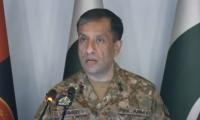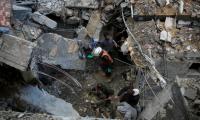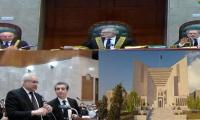To many, the strategic construct of the subcontinent was defined in 1947, when the formation of the two nations from a single body on communal lines wrote the script of their future relationship. There is a lot said on both sides to negate this presumption, but little can defy the reality that what was largely a political struggle took the communal path to its realisation. The division of both Punjab and Bengal point to this incontestable fact of history. The rest was only grouping.
Why should this be important today? Simply, because the two nations find it impossible to break away from this psychosocial binding. Regardless of what colour the two people put on, what shows through are the default stereotypes betraying their entrenched perceptions of the other. No amount of sophistry is able to hide this fact. In fact, the veneer sheds itself so quickly that it even surprises those who embody this historical travesty.
Pakistan’s India problem is currently defined by two potently vicious incidents:
When the Pathankot attack happened and the two sides managed to shun the impulsive impunity in raising war-cries, it seemed things may have been on the mend. Initial steps were taken to bring some civility to how the two sides dealt with the issue. On the Pakistani side, there was readiness to give the possibility a serious review that it may just be non-state actors, had ventured too far in disrupting an emerging rapprochement with India. Modi had recently called on Nawaz Sharif in an extraordinary, unplanned birthday greeting. However, the politics of maturity was soon derailed by ministers, who threatened response in a manner and time of their own choosing. The default had taken over.
Some positives were contrived. The two national security advisers, both sworn enemies in their earlier professional avatars, played their new roles with some equanimity. Pakistan’s Joint Investigation Team (JIT) visited Delhi and Pathankot to develop an evidence base that might help prosecute the suspects. It is unlikely that they found much, or were convinced even before they set foot on Indian soil that nothing of substance would be shared with them. Meanwhile, India’s warrior for all seasons, the driven Manohar Parrikar, junior minister ofor defence, assured his people that there was no way the team would be let into Pathankot, India’s symbolic citadel for nationalist masculinity. Thus the team only got qualified entry but was able to visit the scene of the crime.
Among the negatives, the JIT, yet to make its information formally public, is already being quoted for its conclusion that the attack had been foiled in the first four hours, with all four terrorists killed. This was suitably celebrated by the Indian government and their media in the immediate aftermath. But then there were reports of more firing and at least two more terrorists holding out in domestic quarters and keeping women and children hostage. This brought new life to the drama, which was virtually played out 24/7 on TV screens for three more days, bringing Pakistan and its ‘dastardly policy of exporting terror against innocent Indian women and children’ into focus.
It turned out that there wasn’t anyone else except the four who had been eliminated in the first few hours. That has left many questions about the Indian motive, reinforcing the stereotype in the Pakistani mind of India playing up as much hatred and harm for Pakistan as possible out of a given situation. The Indians are equally convinced that nothing substantive will come out of the JIT visit, which too will fizzle out to become inconsequential like the trial for the Mumbai attacks. Round nth then to the stereotypical mirror imaging of the other.
The episode of Kulbhoshan Yadav, India’s active service naval officer, caught in Pakistan feeding the subversion of the Baloch rebels against the state, is a smoking gun that India is finding difficult to defend. This further complicates an already complex India-Pakistan relationship. It also reflects how the two nations have been kept on a virtual war-path, with only the means changing. The mould of resident animosity that both nations seem entirely incapable of breaking finds expression in ways that have evolved to suit the strategic context.
If earlier kinetic wars defined that expression, the evolving nuclear realities have forced both countries to look for other means, while still pursuing the older purpose. The use of the non-state actors (a euphemism for non-state combatants) gained relevance on both sides. The 1971 evolution of the Mukti Bahini in the former East Pakistan was a direct infringement of another nation’s stability and integrity, which ultimately saw the secession of East Pakistan.
India alleges Pakistan used the mujahideen left-over from 1979 Afghanistan to feed strife in Indian-held Kashmir in 1989. While Pathankot adds to the litany of Indian complaints on this front against Pakistan, Pakistan blames India for using it indigenous assets, as well as those available to it in Afghanistan and Iran, to create trouble in Pakistan.
In this evolution, Yadav is the next step. This is a repetition of the 1971 Mukti Bahini concept, which India used to cut Pakistan to size. Then too, active Indian agents were assisting the Mukti Bahini in a war against the Pakistani state on Pakistani soil. If earlier there was a thin veneer of ‘non-state actors’, it has now graduated to the use of bona fide state actors like Yadav. This is patently regressive for the two nuclear neighbours, who remain in a state of war.
A strategic context defines the war that is enacted with means that conform to the context, for purposes which are inimical and are aimed at delivering victory through other means. It still is war.
The question, then, is how do two warring nations, engaged in an active war – non-kinetic to some but kinetic enough in its ultimate objective – talk about a cooperative and productive relationship? There isn’t a more glaring strategic paradox than the sham that is at play in South Asia. The world will do well to take heed.
The writer is a retired air-vice marshal, former ambassador and a security and political analyst.
Email: shhzdchdhry@yahoo.com
Any progressive society or government will uphold security so that people can utilize their full potential
In Pakistan, we have witnessed erosion of public trust in government institutions
Capability, accountability, and responsiveness don’t quite capture the increasingly important issue of legitimacy
The government can directly influence economic activity through current and capital expenditure
A view of the Supreme Court of Pakistan. — Supreme Court website/FileWhat kind of firewall does the judiciary...
Indian soldiers stand alongside a barbed wire on the Line of Control. — AFP/FileAnti-Pakistan propaganda remains a...







